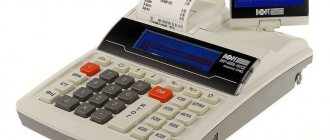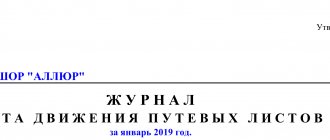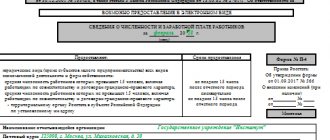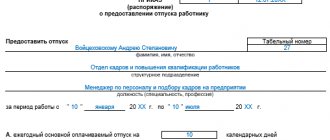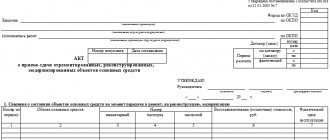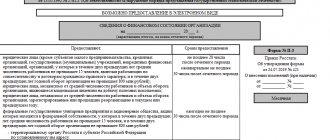Any movement/transfer of cash through the organization's cash desk - in other words, every business transaction involving the receipt or payment of cash - requires proper documentation.
The fact of receipt (acceptance) of cash directly to the cash desk of the enterprise is formalized by drawing up a cash receipt order (PKO).
The fact of payment (expenditure) of cash directly from the enterprise's cash desk is formalized by drawing up a cash expense order (COS).
In addition, these cash orders (CO) - both incoming and outgoing - also require suitable registration records in the enterprise.
Magazine KO-3
The journal for registering incoming and outgoing cash orders (form KO-3) records the primary accounting documents of cash circulation of funds.
The requirement for public sector organizations to reflect them in the registration book is enshrined in Order of the Ministry of Finance dated March 30, 2015 No. 52n. For non-public sector organizations, including non-profit organizations, it is not necessary to use the form (No. 402-FZ). But if an organization decides to use it, it is necessary to consolidate this in its accounting policies.
The form of the book was approved by Resolution of the State Statistics Committee of August 18, 1998 No. 88 and determined by the unified form code 0310003.
conclusions
Form KO-3, used by most domestic enterprises to maintain a journal for registering cash settlements and cash registers, is a convenient register for consolidated accounting of cash documents.
At the same time, business entities have the right to develop and use their own forms for such registers. This opportunity is provided today by current accounting legislation.
It should also be taken into account that filling out this journal today is not at all mandatory for an organization performing cash transactions. However, it is still recommended to maintain it for reasons of increasing accounting efficiency.
What to include in form KO-3
When handling primary accounting documents for cash accounting, you must follow the instructions of the Bank of Russia:
- dated 10/07/2013 No. 3073-U on the procedure for making cash payments;
- dated March 11, 2014 No. 3210-U on conducting cash transactions for accepting cash.
It is necessary to keep records of all “primary” documents that are drawn up when handling cash:
- cash receipt orders (PKO);
- expense cash orders (RKO).
Be sure to include the following information:
- order number;
- date;
- amount;
- notes.
Receipt cash order
When cash is received at the cash desk, a cash receipt order (PKO) is issued in form No. KO-1 in one copy. The PKO receipt is issued to the depositor of money to the cash desk.
When cash proceeds are received from citizens or organizations, a cash receipt receipt is issued, and a cash register receipt is drawn up for the entire amount of revenue for the day based on the control tape. The cashier must enter cash into the cash register before the end of the working day or the arrival of the collector.
The numbering of the PKO is arbitrary, usually in ascending order; you can use a letter code or a date.
Filling out a cash register, sample
It is allowed to keep a journal both using technical means (that is, in electronic form) and in paper form. If the journal is kept in paper form and filled out by hand, you should remember that all its pages must be numbered, stitched with thread and certified with a signature.
Let's look at how to fill out a cash register using an example.
Conventionally, the process can be divided into two parts: filling out the title page and the accounting table.
Step 1. Fill out the title page.
We indicate the name of the organization. If there are no structural divisions, a dash is added. We write code using OKPO according to statistics.
Step 2. We register the period for which records are kept. Also the position and full name of the responsible person.
Next, fill out the tabular part.
Each sheet is divided into two parts: on the left side – registration of receipt orders (RPO); on the right - expense orders (RKO). They are filled in the same way.
Step 3. Fill in the date and serial number of the receipt or expense document.
Step 4. We write down the amount indicated in the document.
Step 5. In the note we briefly indicate the information from whom the money was received or to whom the money was issued, as well as the basis for this.
IMPORTANT!
Corrections and absence of required entries are unacceptable!
Registration requirements
Although you can design the magazine format yourself, there are a number of design requirements that need to be taken into account. In particular, the pages of such a “barn book” must be numbered end-to-end and then stitched. The number of pages must be indicated on the back cover, certified by the signature of an authorized person and the company seal (if used).
The book itself, on each page, consists of two halves of equal volume:
- For receipt orders.
- For expense orders.
It is assumed that one page should be enough for a month, because records must be kept in parallel. Information about the receipt of money at the cash register, and therefore about receipt documents, is usually located on the right, and information about money issued from the cash register (expenses) is on the left.
Do you need a cash register for online cash registers?
In terms of functionality, this is the same device as before, which prints checks and stores information about them. But only now, online cash registers (including when renting an online cash register) need access to the Internet in order to transmit information about completed transactions to the tax office. There is also such a function as sending a receipt to the buyer by email.
Now, thanks to the innovative online cash register, many documents that were approved in the State Statistics Committee Resolution No. 132 dated December 25, 1998 do not need to be used. But this does not apply to documents such as:
- cash register;
- incoming and outgoing orders.
Therefore, the need to keep records in a special book at online cash registers is retained. The maintenance rules are set out in detail in the instructions of the Bank of Russia dated March 11, 2014 No. 3210-U.
Account cash warrant
When issuing money from the cash register, an expense cash order (RKO) is issued in form No. KO-2 in one copy, and the recipient is issued a RKO receipt.
When issuing salaries to full-time employees, a payroll sheet is drawn up in Form No. T-49 or a payroll sheet in Form No. T-53. A RKO is drawn up for the entire amount of the salary paid.
Corrections in PKO and RKO are not allowed; if an error is made, a new document must be drawn up.
Orders can be entered on paper by hand or in an automated manner.
Found documents on the topic “magazine warrant No. 1 Kazakhstan”
- Sample. Registration journal of memorial orders Accounting statements, accounting → Sample.
Registration journal of memorial orders registration journal for 20 - serial numbers date of compilation amount for memorial memorial orders orders -+-+- ... - Magazine—order No. 14 on credit account No. 14
Accounting statements, accounting → Journal order No. 14 for the credit of account No. 14journal - order no. 14 on account credit no. 14 “revaluation of values” for 20 +-+ no. accounts to debit accounts from credit account...
- Magazine—order No. 2 on account credit No. 51
Accounting statements, accounting → Journal order No. 2 for the credit of account No. 51journal - order no. 2 on account credit no. 51 “current account” to debit accounts +-+ str- date 06 26 50 58 60 67 68 69 76 81 93…
- Sample. Magazine—order № 11
Accounting statements, accounting → Sample. Journal-order No. 11journal - order no. 11 on credit accounts no. 40 “finished products”, no. 41 "products", no. 42 “trade margin”, no. 43 "commercial...
- Magazine—order No. 1 on account credit No. 50
Accounting statements, accounting → Journal-order No. 1 for the credit of account No. 50journal - order no. 1 on account credit no. 50 “cash” in the debit of accounts +-+ cash date line 51 70 71 76, etc. total no. ...
- Magazine—order No. 2.1 on account credit No. 52
Accounting statements, accounting → Journal order No. 2.1 for the credit of account No. 52journal - order no. 2/1 on account credit no. 52 “currency account” in debit accounts +-+ statement date line no. no. no. 50 60 etc...
- Sample. Magazine—order № 16
Accounting statements, accounting → Sample. Journal-order No. 16journal - order no. 16 on credit accounts no. 07 “equipment for installation”, no. 08 “capital investments”, no. 11 "animals of...
- Sample. Magazine—order № 8
Accounting statements, accounting → Sample. Journal-order No. 8journal - order no. 8 on credit accounts no. 06 “long-term financial investments”, no. 09 “rental obligations due”, ...
- Sample. Magazine—order № 10.1
Accounting statements, accounting → Sample. Journal-order No. 10.1journal - order no. 10/1 on credit of accounts no. 02 “depreciation of fixed assets”, no. 05 “depreciation of intangible assets”, no. 10 "mother...
- Sample. Magazine—order № 15
Accounting statements, accounting → Sample. Journal-order No. 15journal - order no. 15 on credit accounts no. 80 "profits and losses", no. 81 “use of profits”, no. 83 “future income...
- Sample. Magazine—order № 15
Accounting statements, accounting → Sample. Journal-order No. 15journal - order no. 15 on credit accounts no. 80 "profits and losses", no. 81 “use of profits”, no. 83 “future income...
- Magazine—order No. 7 on credit account No. 71
Accounting statements, accounting → Journal order No. 7 for the credit of account No. 71journal - order no. 7 on account credit no. 71 “settlements with accountable persons” and analytical data for this account for 20...
- Sample. Magazine—order № 13
Accounting statements, accounting → Sample. Journal-order No. 13journal - order no. 13 on account credit no. 01 “fixed assets”, no. 03 “long-term leased fixed assets”, no. 04 "n...
- Sample. Magazine—order № 3
Accounting statements, accounting → Sample. Journal-order No. 3journal - order no. 3 on credit accounts no. 55 “special bank accounts”, no. 56 “monetary documents”, no. 57 “translations on the way”...
- Sample. Magazine—order № 9
Accounting statements, accounting → Sample. Magazine order No. 9journal - order no. 9 on credit accounts no. 78 “settlements with subsidiaries”, no. 79 “intra-economic calculations” and analytics...
Related documents
- Journal of transactions on accounts “c” (instruction of the Central Bank of the Russian Federation dated July 26, 1996 No. 45)
- Journal order No. 1 for credit of account No. 50
- Journal order No. 14 for the credit of account No. 14
- Journal order No. 2 for credit of account No. 51
- Journal order No. 2.1 for the credit of account No. 52
- Journal order No. 6 for the credit of account No. 60
- Journal order No. 7 for the credit of account No. 71
- Borrower's application
- Analytical accounting card for account No. 52 “currency account”
- Cash report. Form No. 5-g
- Worker and employee personal account
- Personal account for saving material resources. Form No. m-20
- Invoice for internal movement of materials. Form No. m-12
- Invoice for internal movement of materials. Form No. m-13
- Invoice for the release of materials to the third party. Form No. m-14
- Invoice for the release of materials to the third party. Form No. m-15
- Working balance (turnover sheet) for synthetic accounts
- Sample. The act of disposal of low-value and high-wear items. Form No. MB-4
- Sample. Act of inventory of precious stones, natural diamonds and products made from them. Form No. inv-9 (Decree of the State Statistics Committee of the USSR dated December 28, 1989 No. 241)
- Sample. Act of inventory of precious metals and products made from them. Form No. inv-8 (Resolution of the USSR State Statistics Committee dated December 28, 1989 No. 241)
Cashier's book. Questions and answers.
2. How to correctly number the cashier’s book (cashier-operator’s journal).
3. How many sheets should there be in the cashier’s book (cashier-operator’s journal).
4. How to properly flash the cashier’s book (cashier-operator’s journal).
5. Filling out the cashier’s book (cashier-operator’s journal) for two or more shift closures per day.
6. Filling out the cashier’s book (cashier-operator’s journal) when paying with bank cards.
7. Filling out the cashier’s book (cashier-operator’s journal) in case of an erroneously issued check or return check (return of goods).
8. How to display in the cashier’s book (cashier-operator’s journal) the amount deposited at the beginning of the shift for issuing change from large bills (change).
9. Brief instructions for operators on filling out the cashier’s book (cashier-operator’s journal).
10. Is it necessary to fill out the cashier’s book (cashier-operator’s journal) if there were no sales.
11. What terms are used for shift closing checks, which are recorded in the cashier’s book (cashier-operator’s journal).
12. Question, “Do we enter the actual amount in the cashier’s book or according to the report.”
13. What is a non-zeroable total? (you can also find the terms Cumulative total, Non-zeroing amount, Accumulation for the entire period, Non-zeroing sales amount).
14. Brief description of the columns for filling out the cashier’s book (cashier-operator’s journal).
15. What is the difference between a refund and a cancellation?
16. Question. “How to fill out the cashier’s book if you forgot to take out the Z report in the evening, and closed the shift in the morning of the next day.”
I read your material on filling out the cashier’s book, but inspectors at the Federal Tax Service require you to fill it out a little differently.
Everything is correct, the material you read is of a general nature. In 90% of cases, this generalized option for filling out the cashier's book will suit everyone, but there is another 10% for regional options for filling out the cashier's book. Therefore, in order to more correctly fill out the cashier’s book, it is advisable for you to seek advice from the Federal Tax Service of Russia at the place of registration of the cash register machine.
How to correctly number the cashier's book (cashier-operator's journal).
The pages of the cashier's book are numbered in a convenient place on the page for the user, as a rule, this is the upper or lower corner of the page (sheet). Numbering in the absence of an automatic numberer is carried out handwritten, ink or with a ballpoint pen. Numbering pages or sheets is a matter of taste, but numbering with sheets is faster and easier. We do not number the cover.
| When numbering, you can start from the document “Instruction of the Central Bank of Russia No. 9 of December 7, 1992.” clause 6.2.2.4. The sheets are numbered with Arabic numerals and sequential numbering in the upper right corner, without affecting the text. |
How many sheets should there be in the cashier’s book (cashier-operator’s journal).
The number of sheets is not limited. However, the standard quantity is 47-52 sheets (94-104 pages).
How to properly flash a cashier's book (cashier-operator's journal).
Theoretically, it is enough to stitch the cashier’s book so that all the sheets of the magazine (it is not necessary to stitch the cover) are stitched, and on the stitching it is possible to put two seals, one the seal of the enterprise, the other the seal of the Federal Tax Service with a mark on the registration of the cashier’s book. However, in practice, it is advisable to stitch the cashier’s book in such a way that it is convenient to work with the magazine and there is no possibility of accidental stitching disruption. Our recommendations are as follows; these recommendations are not mandatory, but are of an advisory nature: The distance between the holes should be at least 3 centimeters. We sew using stitching threads or twine. When using ordinary threads, it is advisable to fold the threads into a rope consisting of four (two) threads. If the magazine is made in the form of sheets of portrait orientation and stapled on the fold, then the easiest way is to stitch such a magazine right through. Use an awl to punch holes together with the cover, thread the threads without touching the cover. This solves two problems. The sewn cashier's book opens in such a way that the stretched threads do not interfere with the opening of the pages. During long-term use, there is no risk of the threads cutting through the page, thereby disrupting the stitching. It is advisable to make the paper for stamps 5 cm * 5 cm + -0.5 in size and glue it to the pages of the magazine, and not to the cover. If the piece of paper is glued to the cover, then a situation is possible when a careless cashier takes hold of the cover and simply tears off the stitching along with the cover.
Filling out the cashier's book (cashier-operator's journal) for two or more shift closures per day.
Filling out the cashier's book in such cases involves two options, provided that the shifts were closed by one operator.
| Rice. An approximate example of filling out a cashier's book is an even page, in the case of two shift closures per day. Fill in two lines. | Rice. An approximate example of filling out a cashier's book on an odd-numbered page, in the case of two shift closures per day. Fill in two lines. |
| Rice. An approximate example of filling out a cashier's book is an even page, in the case of two shift closures per day. Filling in one line (amounts for shift closures, as in the previous example). | Rice. An approximate example of filling out a cashier's book on an odd page, in the case of two shift closures per day. Filling in one line (amounts for shift closures, as in the previous example). |
If the shift was covered by different operators, for example, at facilities with round-the-clock operation, then filling it in one line is not recommended.
| Rice. Sample Z report for KKM Shtrikh-Kombo-FR-K (report No. 10) | Rice. Sample Z report for KKM Shtrikh-Kombo-FR-K (report No. 11) |
Filling out the cashier's book (cashier-operator's journal) when paying with bank cards.
Payment by bank card occurs through a bank terminal. The bank terminal issues two receipts, so-called slips, which are confirmed by a signature or PIN code, depending on the type of card. A slip is not a sufficient document for the release of goods; it only confirms the fact of the transaction of accepting money from the client using a non-cash payment method. Depending on the settings of the cashier’s workplace, then the cash register machine either punches a check using a non-cash payment method, or on the cash register the cashier independently punches a cash register check for the same amount. Filling out the cashier's book differs from the standard one, with only 12 and 13 columns. In the example given, the total revenue is 40,000 rubles. 00 kop. , 30,000 rub. 00 kop. received in cash, RUB 10,000. 00 kop. received by bank card from 6 buyers (6 slips).
| Rice. An approximate example of filling out a cashier's book on an even page when paying with a bank card. | Rice. An approximate example of filling out a cashier's book on an odd page when paying by bank card. |
| Rice. Sample Z report for KKM Shtrikh-Kombo-FR-K with payment by bank card |
Filling out the cashier's book (cashier-operator's journal) in case of an erroneously issued check or return check (return of goods).
When returning a product (an erroneously issued receipt), column 15 is additionally filled in. Column 15 is formed according to the formula 15=10-14. In the example, a refund of 10,000 rubles was made. 00 kop.
An example of filling out a cashier's journal for an operator in case of an erroneously issued check:
| Rice. An approximate example of filling out the cashier's book on an even page, in the event of a returned product or an erroneously punched receipt. | Rice. An approximate sample of filling out the cashier's book on an odd page, in the event of a returned product or an erroneously punched receipt. |
When applying, it is advisable to familiarize yourself with more detailed material. Look.
How to display in the cashier's book (the cashier-operator's journal) the amount deposited at the beginning of the shift for issuing change from large bills (change).
No way. For this purpose, there is a Book of accounting of funds accepted and issued by the cashier in form No. KO-5.
Brief instructions for operators on filling out the cashier's book (cashier-operator journal).
Let me make a reservation right away: the instructions were not written by me, but taken from the actual job description of a cashier. Instructions for filling out the cashier's book, general case. .
Is it necessary to fill out a cashier’s book (cashier-operator’s journal) if there have been no sales?
The cashier's book is not a time sheet, but a display of all shift closures carried out on the cash register. Some cash registers allow you to close a shift with zero revenue. Therefore, if a check for closing a shift has been made, then it must be recorded in the cashier’s book.
What terms are used for shift closing checks, which are recorded in the cashier’s book (cashier-operator’s journal).
The most common is the “Z report” (zet report). “Daily report with cancellation”, “Closing shift”, “Report with cancellation” are also applicable. And the outdated “Control tape”, “Blanking”.
Question, “Do we enter the actual amount into the cashier’s book or according to the z report”.
The correct answer will be both the actual amount and the amount according to the z report. The amount on the Z report ALWAYS written in column 10 of the cashier's book. But columns 11,13,14,15 serve to correctly format the actual amount.
What is a non-zeroable total? (you can also find the terms Cumulative total, Non-zeroing amount, Accumulation for the entire period, Non-zeroing sales amount).
A non-zeroable total is the cumulative sum of all shift closures (Z-reports) for a certain period. On some cash registers, the non-zeroable total is the sum of all Z-reports for the entire period of operation of the cash register, on others it is the sum of all Z-reports for the last registration. Thus, when putting the cash register into operation, the cashier’s book will always start with a non-zeroable total of 1 rub. 11 kopecks. In the case of re-registration of a cash register, the cashier’s book can begin either with a non-zeroable total of 1 rub. 11 kopecks or with a non-zeroable total of the previous owner. At what amount the cashier’s book will start after re-registration depends on the cash register model.
A brief description of the columns for filling out the cashier's book (cashier-operator's journal).
1. “Date, (shift).” Even here the simplicity of the wording causes some discrepancies. This column is filled in in HH/MM format, that is, January 22, 2007 will look like 01/22. However, it is recommended that in the first line (the top one) you fill in the date in the HH/MM/YY format; the above date will look like this - 01/22/07. Further filling of lines is in HH/MM format. A common mistake in filling out this column is filling it in advance with dates from the calendar. When filling in this way, it is necessary to fill out the lines of the cashier’s book, even if the Z-report was not taken.
Rice. Desirable option for filling in the first column
2. “Department (section) number.” A very controversial column to fill out. This column is filled in if the cash register serves several trading sections, and the organization maintains separate revenue accounting for them. In practice, filling out this column was not encountered. No comments.
3. “Last name, first name, patronymic of the cashier.” The cashier's name at the beginning of the shift is entered in this column. The essence of this column is simple: the cashier will sign for the amount of the non-zeroable total at the beginning of the shift and for the proceeds handed over to the director. In practice, the cashier, as a rule, accepts a certain amount of change at the beginning of the day, although he signs in the cashier’s book only for the amount of the non-zeroable total. The amount of change in cash is not provided in the standard columns. Experienced administrators make do with maintaining internal documentation to simplify control over the actual management of cash in the cash register. A common mistake in filling out this column is filling it out from a person who does not have an employment contract with the employer (in practice, this also happens), or a person who does not have financial responsibility.
4. “The serial number of the control counter (fiscal memory report) at the end of the working day (shift).” There are many discrepancies here, most write down the Z-report number in this column, others write down the check number at the end of the day, there is a Z-report check number, the next category does not fill out this column at all due to its vague wording, awaiting clarifications (punishments) from the inspectors. This column makes sense to fill out only if sales are carried out on a cash register, which does not highlight the amount of a non-zeroable total on the X-report. The fact is that the cashier, when signing for the amount of the non-zeroable total at the beginning of the shift, working on such cash registers, does not actually see this amount, therefore it is the number of the Z-report (check) that can confirm the accuracy of exactly that amount of the non-zeroable total at the beginning of the shift. In other words, it is this column that guarantees the cashier’s protection from cases when the cashier, without observing the documentary display of the non-zeroable total at the beginning of the shift, signs in the cashier’s book for this amount. I would like to note that most modern cash register equipment, when generating an X-report, still displays a non-zeroable total at the beginning of the shift in a separate line. A common mistake in filling out this column is filling in the case when we are talking about the Z-report number, then this is a discrepancy between the actual Z-report number and the real one, respectively, also applies to the check number.
5. “Readings of the control counter (fiscal memory report), recording the number of transfers of the readings of the summing money counter” see clause 4.
6. “Readings of summing cash counters at the beginning of the working day (shift) amount, rub. cop." This column does not raise questions when filling out only in the case when the cash register allocates the amount of a non-zeroable total at the beginning of the shift in the X-report. Otherwise, filling out this column is chaotic and depends only on the literacy and experience of the administrator filling out the cashier’s book. If there is no line of non-zeroable total at the beginning of the shift in the X-report, you will have to be guided by indirect indicators - the number of the check, the last one in the previous shift, or contact the central service center for qualified advice. If the X-report shows a non-zeroable total, then when filling out this column it should be compared with the reading of column 9 in the higher line; in fact, this column (9) is a display of this column (6). If the amount in column 9 does not coincide with the amount of the non-zeroable total, you need to stop filling out the cashier’s book and contact the central service center for advice, most likely your cash register is broken. It should be remembered that on a working cash register, the amount of the non-zeroable total at the end of the shift always coincides with the amount of the non-zeroable total at the beginning of the shift. A common mistake in filling out this column is filling in reports that do not show the actual non-zeroing total, filling out a Z-report not according to the non-zeroable amount, filling out based on current revenue, etc. Another common mistake is filling out this column immediately after the end of the shift; this column is filled out only at the beginning of the shift. For example: when closing a shift, the person responsible for filling out the cashier’s book rewrites the revenue for the day in the morning, in the morning the cash register breaks down and the central control center ends up, and for technological purposes, the cash register amounts are entered into the central control center and closed with the KM2 form. However, since the amount at the beginning of the day has already been recorded, disagreements arise in the cashier’s book.
Rice. The principle of filling out the sixth column of the cashier's book
7. “Readings of summing cash counters at the beginning of the working day (shift) signature of the cashier.” This column does not raise questions when filling out only in the case when the cash register allocates the amount of a non-zeroable total at the beginning of the shift in the X-report. Otherwise, the cashier actually signs for the non-zeroable total indicated in the previous line at the end of the shift. The problem is that in this case, after the Z-report has been withdrawn, you can enter a certain amount and withdraw another Z-report, then in fact this Z-report cannot be controlled in any way except by the check number (if such numbering is carried out in column 4) . From the recommendations for filling out this column, if the X-report does not display a non-zeroable total, then rewrite the revenue at the end of the day from column 9 to column 6 and only then sign in this column. A common mistake in filling out this column is filling it out from a person who does not have an employment contract with the employer (in practice, this also happens), or a person who does not have financial responsibility.
8. “Readings of summing cash counters at the beginning of the working day (shift) signature of the administrator.” See paragraph 7.
9. “Readings of summing cash counters at the end of the working day (shift) amount, rub. cop." This column does not raise questions when filling out, since the cash register allocates the amount of a non-zeroable total at the end of the shift in the Z-report. I would like to note the fact that this column is actually a reflection of column 6 of the following line. A common mistake in filling out this column is filling in on reports that do not show the actual non-zeroable total or filling in a Z-report that is not based on the non-zeroable amount.
10. “Amount of revenue per working day (shift), rub. cop." This column is a display of revenue according to the Z-report. A common mistake in filling out this column is filling in according to current cash; it should be noted that cash in the cash register does not always correspond to revenue for the day according to the Z-report.
Rice. The principle of forming the 10th column
11. “Deposited in cash RUB. cop." This column corresponds to the cash amount of all sales. It should be noted that if in the current shift there are entries in column 15 (that is, return transactions or erroneously issued checks), then the amount minus column 15 is recorded in this column. If at the cashier’s workplace there is a bank terminal for accepting non-cash payments from the public, then revenue processed using cards is not taken into account in this column.
12. “Delivered, quantity paid according to documents.” A rarely used column, the number of slips is recorded here. A common mistake in filling out this column is not filling it in when using bank terminals.
13. “Delivered, paid according to the documents, the amount is rubles. cop." A rarely used column, the total amount of sales carried out through bank terminals is recorded here. A common mistake in filling out this column is not filling it in when using bank terminals.
14. “Only rubles rented.” cop." in fact, this column is the sum of columns 11 and 13. In 1C language, this column is a display of 51 accounts.
15. “The amount of money returned to buyers (clients) for unused cash receipts, rub. cop." Here you should familiarize yourself with the general principles of the procedure for returning goods (unused cash receipts). A common mistake in filling out this column is filling it out without all the necessary documents.
16. “Signature at the end of the working day (shift) of the cashier.” Here everything is very simple: handing over the proceeds - signing for the amount handed over.
17. “Signature at the end of the cashier’s working day (shift”). Here everything was very simple: he accepted the proceeds - he signed for the accepted amount.
18. “Signature at the end of the working day (shift) of the cashier.” Here everything was very simple: he accepted the proceeds - he signed for the accepted amount.
| Rice. An approximate sample of filling out a cashier's book, even page | Rice. An approximate sample of filling out a cashier's book, odd page |
What is the difference between a refund and a cancellation?
To simplify greatly and not go into details.
A refund is a cash transaction with a cash receipt already completed.
A cancellation is a cash transaction involving an incomplete cash receipt.
The fundamental difference between these operations is from the point of view of cash register.
Return - does not delete the check and, accordingly, does not reduce revenue, but only records the very fact of the operation of returning money to the buyer (there is a persistent misconception among KKM users that the return operation reduces current revenue - this is not true, when returning the revenue does not decrease, only the amount of cash in KKM). The second important difference is the fact that the return operation can only be performed if several conditions are met, for example, if the amount of cash in the cash register is less than the return amount, then the return operation cannot be performed. The third difference between the return operation is the need to record this operation in the cashier’s book and fill out the necessary documentation.
Canceling – deletes the cash receipt completely and reduces the revenue for the day (to be more precise, the amount of the canceled check is not added to the revenue for the day). You can cancel the entire receipt, or one or more purchases in the receipt (there is a persistent misconception among buyers that the cancellation operation does not remove the purchase from the receipt; the buyer sees a line with the product and the amount at the beginning of the receipt, but does not pay attention to a similar line slightly lower marked cancellation - this is not true; if the receipt has a line marked cancellation, it means the purchase has been removed from the receipt). The second important difference is the fact that the cancellation operation can only be performed on an unfinished check, but if the cash register receipt has already left the cash register, then the cancellation operation cannot be performed. The third difference between the cancellation operation is the absence of the need to record this operation anywhere, be it the cashier’s book or other documentation.
Question. “How to fill out the cashier’s book if you forgot to take out the Z report in the evening, and closed the shift in the morning of the next day.”
It should be noted that the cashier’s book (a journal in the KM4 form) is not a time sheet for cashiers’ work, but is a document recording Z-reports (shift closings) taken on the cash register. Correct answer: with the date Z the report was taken, we fill out the line in the cashier’s book. An attempt to record a report with an incorrect date in the cashier's book Z is erroneous - the full fiscal report for FP will still show the actual closing date of the shift
This question has two aspects, accounting and technical.
Technically, if the cash register is controlled from software, then subsequent sales may be blocked, since the program (on the computer) considers that the day is already closed. For autonomous cash registers, the technical aspect is not relevant; in principle, such a problem cannot arise there, due to the lack of software for managing cash registers.
Accounting, here everything is somewhat more complicated. For example, on September 30 they forgot to withdraw the Z report, the money was handed over to the bank on September 30, and the shift at the cash desk was closed on October 1. During a tax audit, the monthly (quarterly) fiscal report from the cash register will show a slightly different amount than from the accounting accounts. Accounting will have to work hard to explain the reason for such a discrepancy in amounts in the reporting period. An important note: if you make a Z report on the wrong day, be sure to notify the accounting department about this fact, then an experienced accountant will decide for himself how to correctly draw up the receipts and expenses documents for the accounting department (not in the cashier’s book).


